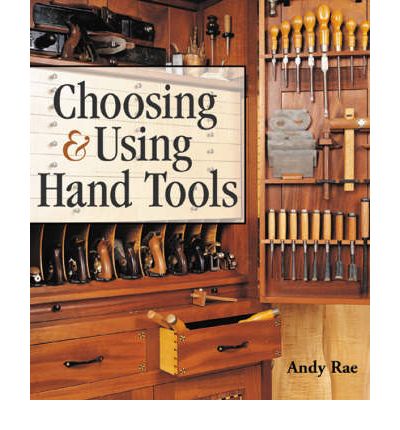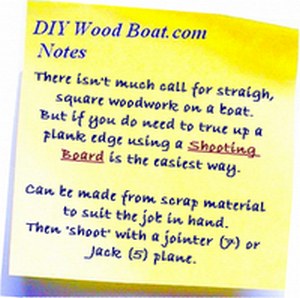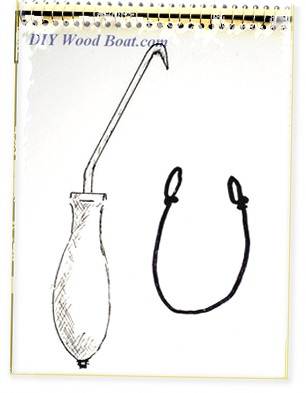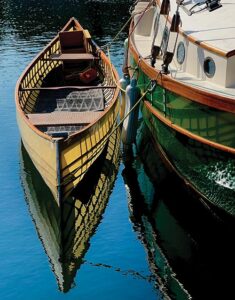- Home
- Boat Building
- Restoration
- Tools
- Bench Planes
Bench Planes
These are the Bench Planes the wooden boat builder is most likely to need.
Planes are the everyday workhorses in the woodworker arsenal.
They are used mainly to pare blanks down to finished dimensions and to create a smooth crisp surface on the finished article.
A good quality plane properly looked after will last a lifetime.
The swish of a sharp bench plane as it shaves a work-piece to a crisp clean finish superbly satisfying.
There are very expensive high quality planes which are like precious jewels, however they are for the specialist cabinet maker.
At the other end of the scale there are some very cheap bench planes which won't last and will be frustrating to use.
Wooden planes are lighter than the metal ones and they will skim beautifully across the surface.
However most wooden ones are not easy to adjust and good ones are expensive.
Metal planes are cheaper because they can be mass produced.
They can be bought with corrugated soles which run more freely on resinous wood.
An old plane can be rejuvenated with a good quality new blade, cap iron and /or new handles.
There are a hundred and one different specialist bench planes on the market, it is up to the individual to determine what he needs and how much he wishes to spend.
affiliate linksScrub plane.
This bench plane is designed for quick roughing to size before smoothing.
The convex cutting edge on the extra thick blade can remove material quickly with out chatter.
Normally it is used diagonally across the grain.
It can however also be used, because of its convex blade, to hollow the backs of planks.
Usually has a sole of just over 10inch long.Try / Jointer Plane.
The Try or Jointer Planes (No 7) are the extra long bench planes with soles of up to 2ft long.
The reason for the length is to bridge any undulations in the plank so the plane does not follow any dips.
It is particularly useful on when cleaning up the edges of long planks prior to edge to edge joining.
Because of the length, the metal ones are heavy, so it might be worth the extra care needed to adjust a wooden plane in exchange for its lightness.
affiliate linksFore plane .
Fore planes (No 6) have a sole of about 1ft 6inch long.
These are ideal for flattening and leveling large and long surfaces.
affiliate linksJack plane.
The Jack plane( No 5) is probably the most used bench plane.
If you only wish to buy one plane then this has got to be the one.
This regular work-horse has a sole of just over 1ft so it is handier to use on most jobs yet the length can still bridge those dips.
affiliate linksSmoothing plane.
The Smoothing planes (No 4) because of their size are the most commonly used bench planes for smoothing trimming and finishing.
The No4 has a sole length of about 9inch though smaller smoothing planes are available.
For smooth finishing the blade should be adjusted for very fine skimming.
Rebate / rabbet plane.
Rebate or rabbet planes are specialist planes designed, believe it or not, to cut rebates or shoulders.
Some come with depth stops and fence guides to ensure consistent accuracy.
And some can also be converted into chisel planes to allow you to work into corners.
affiliate linksBlock plane.
The Block plane is a small light weight plane that can be used one handed.
The blade is usually set at a lower angle than on the other bench planes.
This means that they are eminently suitable for planning end grain.
An angle of 20% is the standard.
Planes with low angle blade set at 12% are also available.
When reassembling a block plane or, any plane with a low angle blade after sharpening , the honed bevel must be fitted uppermost.Japanese Bench Planes.
Japanese bench planes are becoming increasingly popular and more widely available.
Despite their deceptively simple wooden construction they have gained legendary repute for their quality.
The blades have a thin layer of high carbon steel laminated on to thick soft steel.
The high carbon steel provides a superb cutting edge, while the thick low carbon backing helps to absorb any chatter.
affiliate linksMulti /Combination planes.
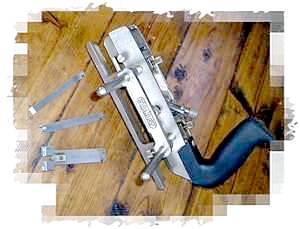
The Combination plane is a plough plane which will take a variety of blades.
They may look complicated but are quit simple to set up.
The depth gauge and fence will ensure consistent accuracy.
And they will take a variety of different width blades for fluting beading and for making tongue and groves.
The Multi plane is basically the same but has additional features.
affiliate linksSpokeshave.
Spoke shaves are designed for smoothing curved surfaces.
They are made with different faces or soles.
The flat soled variety are used to smooth convex surfaces however, this can be done with a smoothing or block plane.
For finishing concave surfaces the round faced spoke shave with its convex base is a must.
The half round spoke shave has a concave blade and base specially for shaping and smoothing curved pieces such as spokes, hence the name.
The radiused type is useful for scooping out hollows. Despite the two handled grip spoke shaves do require some practice to get the action working properly. affiliate linksDraw knife.
OK, so the draw knife isn't exactly a bench plane however this versatile tool can quickly shape parts ready for finishing.
It is an ideal tool for shaping spars and the like.
This is another tool which requires a little practice to control.
As there is no sole, the depth of cut is controlled by how it is held. affiliate linksBeading tool.
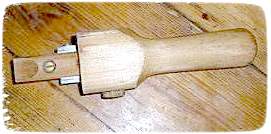
This simple little tool is superb for putting fine finishing detail on by hand.
It can be used on either the push or pull direction.
Different shaped blades can be bought, however it is relatively easy to make your own.
Just take care that the blade isn't allowed to follow the grain rather than being controlled by the stop.
Rasps.
The rasp is a tool that a cabinet maker or high class wood worker would probably never admit to having in their tool box.
But they are useful tools especially for an amateur boat builder who doesn't wish to spend thousands on specialist equipment.
Wood files such as the 'surform' type come in a variety of blade shapes excellent for shaping those curvy details.
They are also useful when dealing with wood such as Iroko which has difficult grain.
Rifflers are small double ended files which are perfect for cleaning up any small nook or cranny in carved details.
affiliate linksScrapers.
The Basic scraper is rectangle of supple, tempered steel with a burnished edge.
They are also available in a variety of curved shapes.
The sharp metal edge removes very fine shavings to leave superior finish.
The scraping or cutting is controlled by the angle it is held at and by the amount of curvature induced in the scraper.
There are fortunately, scraper holders which are easy to hold and which can be adjusted for bow.
One of the tricks to good scraping is getting the correct angle to the burr on the burnished edge.
Once again tool makers have come to the rescue with handy little gadgets which make this easy.The point of using a cabinet scraper is to produce a very fine sharp finish without the clogged grain and softened edge that sanding produces.
Hook scrapers with wooden handles and disposable blades are designed for removing paint varnish rust etc from surfaces prior to re-finishing. affiliate linksCarpenters Adze
The Adze was traditionally designed for
smoothing and shaping large areas of timber.
Now used for a number of purposes in squaring and shaping timbers.
